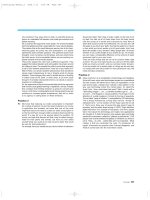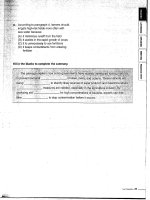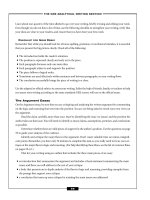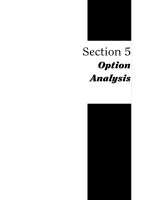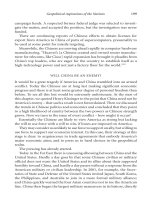The gre anlytycal writting section 5 ppt
Bạn đang xem bản rút gọn của tài liệu. Xem và tải ngay bản đầy đủ của tài liệu tại đây (124.57 KB, 6 trang )
Operations with Decimals
To add and subtract decimals, you must always remember to line up the decimal points:
356.7 3.456 8.9347
+ 34.9854 + .333 – 0.24
391.6854 3.789 8.6947
To multiply decimals, it is not necessary to align decimal points. Simply perform the multiplication as if there
were no decimal point. Then, to determine the placement of the decimal point in the answer,count the numbers
located to the right of the decimal point in the decimals being multiplied. The total numbers to the right of the
decimal point in the original problem is the number of places the decimal point is moved in the product.
For example:
To divide a decimal by another, such as 13.916 Ϭ 2.45 or 2.45ͤ13
ෆ
.9
ෆ
16
ෆ
, move the decimal point in the
divisor to the right until the divisor becomes a whole number. Next, move the decimal point in the dividend
the same number of places:
This process results in the correct position of the decimal point in the quotient. The problem can now be
solved by performing simple long division:
Percents
A percent is a measure of a part to a whole, with the whole being equal to 100.
■
To change a decimal to a percentage, move the decimal point two units to the right and add a percent-
age symbol.
245
1391.6
5.68
–1225
166 6
–1470
1960
1391.6
245
1 2.3 4
2
2
x .5 6
1
2
3
4
7 4 0 4
6 1 7 0 0
6.9 1 0 4
1
2
3
4
= TOTAL #'s TO THE RIGHT OF
THE DECIMAL POINT = 4
– THE GRE QUANTITATIVE SECTION–
160
Examples:
.45 = 45% .07 = 7% .9 = 90%
■
To change a fraction to a percentage, first change the fraction to a decimal. To do this, divide the
numerator by the denominator. Then change the decimal to a percentage by moving the decimal two
places to the right.
Examples:
ᎏ
4
5
ᎏ
= .80 = 80%
ᎏ
2
5
ᎏ
= .4 = 40%
ᎏ
1
8
ᎏ
= .125 = 12.5%
■
To change a percentage to a decimal, simply move the decimal point two places to the left and elimi-
nate the percentage symbol.
Examples:
64% = .64 87% = .87 7% = .07
■
To change a percentage to a fraction, divide by 100 and reduce.
Examples:
64% =
ᎏ
1
6
0
4
0
ᎏ
=
ᎏ
1
2
6
5
ᎏ
75% =
ᎏ
1
7
0
5
0
ᎏ
=
ᎏ
3
4
ᎏ
82% =
ᎏ
1
8
0
2
0
ᎏ
=
ᎏ
4
5
1
0
ᎏ
■
Keep in mind that any percentage that is 100 or greater will need to reflect a whole number or mixed
number when converted.
Examples:
125% = 1.25 or 1
ᎏ
1
4
ᎏ
350% = 3.5 or 3
ᎏ
1
2
ᎏ
Here are some conversions with which you should be familiar:
FRACTION DECIMAL PERCENTAGE
ᎏ
1
2
ᎏ
.5 50%
ᎏ
1
4
ᎏ
.25 25%
ᎏ
1
3
ᎏ
.333 . . . 33.3
–
%
ᎏ
2
3
ᎏ
.666 . . . 66.6
–
%
ᎏ
1
1
0
ᎏ
.1 10%
ᎏ
1
8
ᎏ
.125 12.5%
ᎏ
1
6
ᎏ
.1666 . . . 16.6
–
%
ᎏ
1
5
ᎏ
.2 20%
– THE GRE QUANTITATIVE SECTION–
161
Order of Operations
An order for doing every mathematical operation is illustrated by the following acronym: P
lease Excuse My
D
ear Aunt Sally. Here is what it means mathematically:
P: Parentheses. Perform all operations within parentheses first.
E: Exponents. Evaluate exponents.
M/D: Multiply/Divide. Work from left to right in your subtraction.
A/S: Add/Subtract. Work from left to right in your subtraction.
Example:
5 +
ᎏ
(3
2
–
0
2)
2
ᎏ
= 5 +
ᎏ
(
2
1
0
)
2
ᎏ
= 5 +
ᎏ
2
1
0
ᎏ
= 5 + 20
= 25
Exponents
An exponent tells you how many times the number, called the base, is a factor in the product.
Example:
2
5–exponent
= 2 ϫ 2 ϫ 2 ϫ 2 ϫ 2 = 32
⇑
base
Sometimes, you will see an exponent with a variable: b
n
. The b represents a number that will be
multiplied by itself n times.
Example:
b
n
where b = 5 and n = 3
b
n
= 5
3
= 5 ϫ 5 ϫ 5 = 125
Don’t let the variables fool you. Most expressions are very easy once you substitute in numbers.
Laws of Exponents
■
Any nonzero base to the zero power is always 1.
Examples:
5 = 1 70
º
= 1 29,874
º
= 1
– THE GRE QUANTITATIVE SECTION–
162
■
When multiplying identical bases, you add the exponents.
Examples:
2
2
ϫ 2
4
ϫ 2
6
ϭ 2
12
a
2
ϫ a
3
ϫ a
5
ϭ a
10
■
When dividing identical bases, you subtract the exponents.
Examples:
ᎏ
2
2
5
3
ᎏ
= 2
2
ᎏ
a
a
7
4
ᎏ
= a
3
Here is another method of illustrating multiplication and division of exponents:
b
m ϫ
b
n
ϭ b
m ϩ n
ᎏ
b
b
m
n
ᎏ
= b
m – n
■
If an exponent appears outside of parentheses, you multiply the exponents together.
Examples:
(3
3
)
7
ϭ 3
21
(g
4
)
3
ϭ g
12
■
Exponents can also be negative. The following are rules for negative exponents:
m
–1
ϭ
ᎏ
m
1
ᎏ
5
–1
ϭ
ᎏ
5
1
1
ᎏ
ϭ
ᎏ
1
5
ᎏ
m
–2
ϭ
ᎏ
m
1
2
ᎏ
5
–2
ϭ
ᎏ
5
1
2
ᎏ
ϭ
ᎏ
2
1
5
ᎏ
m
–3
ϭ
ᎏ
m
1
3
ᎏ
5
–3
ϭ
ᎏ
5
1
3
ᎏ
ϭ
ᎏ
1
1
25
ᎏ
m
–n
ϭ
ᎏ
m
1
n
ᎏ
for all integers n.
If m ϭ 0, then these expressions are undefined.
Squares and Square Roots
The square of a number is the product of a number and itself. For example, in the expression 3
2
ϭ 3 ϫ 3 ϭ 9,
the number 9 is the square of the number 3. If we reverse the process, we can say that the number 3 is the
square root of the number 9. The symbol for square root is ͙
ෆ
and is called the radical. The number inside
of the radical is called the radicand.
Example:
5
2
= 25; therefore, ͙25
ෆ
= 5
Since 25 is the square of 5, we also know that 5 is the square root of 25.
– THE GRE QUANTITATIVE SECTION–
163
Perfect Squares
The square root of a number might not be a whole number. For example, the square root of 7 is 2.645751311 . . .
It is not possible to find a whole number that can be multiplied by itself to equal 7. A whole number is a
perfect square if its square root is also a whole number. Examples of perfect squares: 1, 4, 9, 16, 25, 36, 49, 64,
81,100,
Properties of Square Root Radicals
■
The product of the square roots of two numbers is the same as the square root of their product.
Example:
͙a
ෆ
× ͙b
ෆ
= ͙a × b
ෆ
͙5
ෆ
× ͙3
ෆ
= ͙15ෆ
■
The quotient of the square roots of two numbers is the square root of the quotient.
Example:
ϭ
Ί
( b 0)
ϭ
Ί
ϭ 5
■
The square of a square root radical is the radicand.
Example:
(͙n
ෆ
)
2
= n
(͙3
ෆ
)
2
= ͙3
ෆ
· ͙3
ෆ
= ͙9
ෆ
= 3
■
To combine square root radicals with the same radicands, combine their coefficients and keep the same
radical factor. You may add or subtract radicals with the same radicand.
Example:
a͙b
ෆ
+ c͙b
ෆ
= (a + c)͙b
ෆ
4͙3
ෆ
+ 2͙3
ෆ
= 6͙3
ෆ
■
Radicals cannot be combined using addition and subtraction.
Example:
͙a + b
ෆ
≠ ͙a
ෆ
+ ͙b
ෆ
͙4 + 11
ෆ
≠ ͙4
ෆ
+ ͙11
ෆ
15
ᎏ
3
͙15
ෆ
ᎏ
͙3
ෆ
a
ᎏ
b
͙a
ෆ
ᎏ
͙b
ෆ
– THE GRE QUANTITATIVE SECTION–
164
■
To simplify a square root radical, write the radicand as the product of two factors, with one number
being the largest perfect square factor. Then write the radical of each factor and simplify.
Example:
͙8
ෆ
= ͙4
ෆ
ϫ ͙2
ෆ
= 2͙2
ෆ
Ratio
The ratio of the numbers 10 to 30 can be expressed in several ways, for example:
10 to 30 or
10:30 or
ᎏ
1
3
0
0
ᎏ
Since a ratio is also an implied division, it can be reduced to lowest terms. Therefore, since both 10 and 30
are multiples of 10, the above ratio can be written as:
1 to 3 or
1:3 or
ᎏ
1
3
ᎏ
Algebra Review
Congratulations on completing the arithmetic section. Fortunately, you will only need to know a small por-
tion of algebra normally taught in a high school algebra course for the GRE. The following section outlines
only the essential concepts and skills you will need for success on the GRE Quantitative section.
Equations
An equation is solved by finding a number that is equal to a certain variable.
SIMPLE RULES FOR WORKING WITH EQUATIONS
1. The equal sign seperates an equation into two sides.
2. Whenever an operation is performed on one side, the same operation must be performed on the other side.
3. Your first goal is to get all the variables on one side and all the numbers on the other.
4. The final step often is to divide each side by the coefficient, leaving the variable equal to a number.
– THE GRE QUANTITATIVE SECTION–
165

